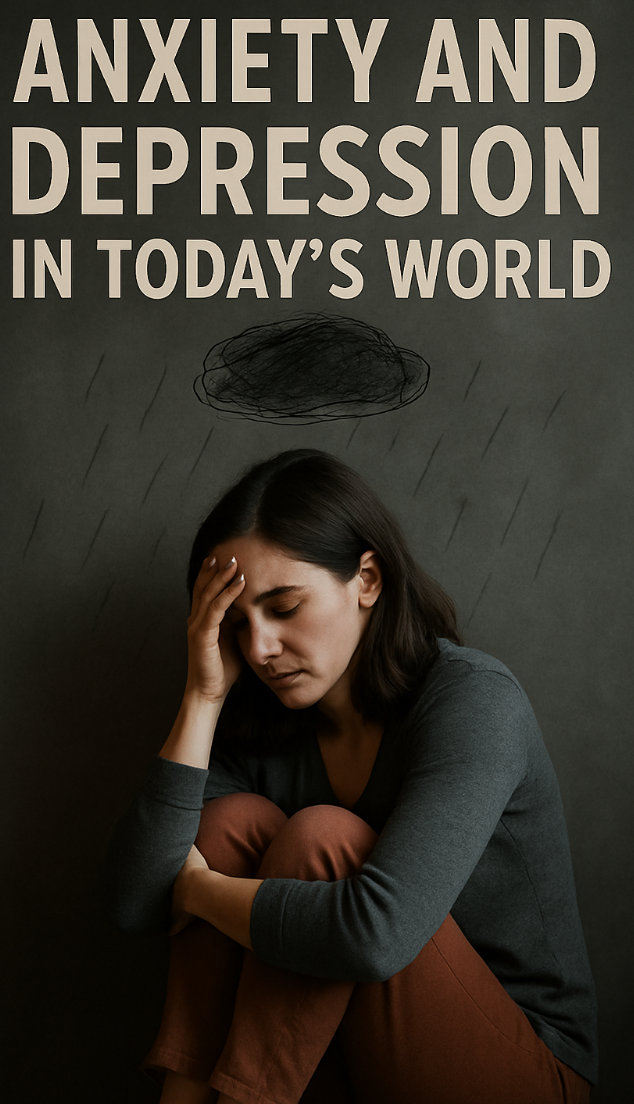The Dual Burden: Understanding Anxiety and Depression in Today’s World
The Dual Burden: Understanding Anxiety and Depression in Today’s World
HEALTH
MrTruth.Tv
9/17/20256 min read
Anxiety and depression are two of the most pervasive mental health challenges facing the world today. Their impacts—emotional, physical, social, economic—are vast and complex. While many people experience one or the other, a large proportion experience both simultaneously, complicating diagnosis, treatment, and recovery. As global rates rise, understanding the causes, the burden, and effective response strategies is ever more critical.
This article explores: current prevalence and trends; underlying factors; how they overlap and diverge; consequences; diagnosis and treatment challenges; and what evidence suggests for prevention and policy.
Prevalence & Trends
Global and Demographic Patterns
According to a global study of anxiety disorders, in 2019 the prevalence was about 4.05% among the global population (uncertainty interval: 3.39–4.78%), rising in absolute numbers from ~195 million to ~301 million people between 1990 and 2019. SpringerOpen
The prevalence of depression and anxiety in the elderly globally is estimated at 19.2% for depression (95% CI: 13.0–27.5%) and 16.5% for anxiety (95% CI: 11.1–22.8%). BioMed Central
Among adults living with chronic pain, rates are especially high: ~39.3% for depression and 40.2% for anxiety. PMC
Youth & Adolescents
A systematic review of 61 articles found significant increases in anxiety and depression among children and adolescents worldwide, compared to pre-pandemic levels. Key risk factors include previous mental health problems and excessive media exposure; protective factors include strong family communication and social support. PMC
Clinically diagnosed depression and/or anxiety appears in young people with alarming frequency; comorbidity (i.e. having both) is common. JAMA Network+2Psychiatry Online+2
Gender, Age & Other Differences
Women are more likely to suffer from both anxiety and depression than men in many studies. SpringerOpen+1
Younger adults tend to report higher levels of anxiety and depression (or more severe symptoms) than older adults in many datasets. For example, studies using computational language assessment methods found that adults aged 16‐29 had greater prevalence of severe anxiety and depression than older cohorts. Nature
Risk Factors & Drivers
The growth in anxiety and depression cases globally likely arises from the interaction of multiple risk factors, many of which are increasing in prevalence or intensity.
Biological & Psychological Factors
Genetics play a role: family history of depression or anxiety increases risk.
Neurochemical imbalances, especially involving serotonin, norepinephrine, dopamine, and other neurotransmitters, have been long implicated in both conditions.
Psychological traumas—childhood trauma, abuse, neglect—contribute significantly.
Certain personality traits such as high neuroticism and low resilience are associated with higher risk.
Social, Environmental & Societal Stressors
COVID-19 pandemic: Lockdowns, social isolation, fear of illness, economic disruption — these have spurred sharp increases, especially among younger people. PMC+1
Media exposure and social media: Overuse, especially in youth, has been correlated with worsened anxiety and depressive symptoms due to comparison, cyberbullying, misinformation. PMC+1
Economic stress: Job insecurity, poverty, rising cost of living, inequality.
Physical health issues: Chronic pain, long‐term disease, disability. As noted, people with chronic pain have ~40% prevalence of clinical depression and anxiety. PMC
Aging: Elderly individuals face higher risk due to isolation, comorbid physical illnesses, loss of spouse/friends, retirement, reduced mobility. BioMed Central
Protective Factors
Strong family, community, and social support networks.
Access to mental health resources (counseling, therapy).
Physical activity, adequate sleep, healthy nutrition.
Resilience training, coping skills.
Policies supporting mental health in education, work environments, and primary care.
Comorbidity: How Anxiety & Depression Interact
Anxiety and depression often occur together. Some of the critical points:
It is common for someone with an anxiety disorder to also meet criteria for depression at some point; likewise for those with depression to have anxiety symptoms. JAMA Network+1
Having both tends to worsen prognosis: greater symptom severity, lower likelihood of full recovery, higher relapse rates. Psychiatry Online
The Tripartite Model (Watson & Clark) helps clarify overlap and distinction: it proposes three components—negative affect (shared by both), physiological hyperarousal (more specific to anxiety), and low positive affect (more specific to depression). Wikipedia
Consequences & Burden
Beyond mental distress, the implications of untreated or poorly treated anxiety and depression are serious.
Physical Health: Increased risk of cardiovascular disease, immune dysregulation, chronic pain—and poorer outcomes for coexisting medical conditions.
Functional Impairment: Difficulty in work, school, relationships. Reduced productivity, absenteeism, and even unemployment.
Quality of Life: Sleep disruption, social withdrawal, loss of interest in enjoyable activities.
Economic Costs: Healthcare expenses, lost work output, cost of disability.
Risk of Suicide: Elevated risk, especially when depression is involved and/or when comorbid with anxiety.
Diagnostic & Treatment Challenges
Diagnosis
Overlap of symptoms can complicate distinguishing whether one disorder predominates, or whether both are present.
Symptoms often manifest differently across ages, genders, cultures; older adults might express depression via somatic complaints; youth may show irritability rather than sadness.
Stigma continues to hinder seeking help.
Treatment
Psychotherapy: Cognitive Behavioural Therapy (CBT), Interpersonal Therapy (IPT), Acceptance and Commitment Therapy (ACT) are among well-supported approaches.
Medication: SSRIs (selective serotonin reuptake inhibitors), SNRIs, other antidepressants are frequently used. Anxiety may also involve anxiolytics in some cases.
For comorbid anxiety‐depression, combined therapy + medication tends to have better outcomes.
However, many people do not receive adequate treatment. Access is uneven globally; resources are scarce in low and middle income countries.
Emerging Tools & Research
Digital phenotyping: using wearable sensors + self-reported data to detect patterns of activity, sleep, physiological markers correlated with anxiety/depression. arXiv
Behavioral markers: Novel studies using head motion, voice, language, etc. to predict severity. arXiv+1
Machine learning models: For predicting risk, early detection. arXiv+1
Prevention & Policy
Given the scale of the issue, policy and prevention strategies are essential.
At the Individual Level
Promote healthy lifestyle: regular physical activity, balanced nutrition, sleep hygiene.
Strengthen social support networks; encourage relationships, social engagement.
Stress‐reduction techniques: mindfulness, meditation, relaxation exercises.
Early intervention: recognition of symptoms, reducing delay in treatment.
At the Community & Systems Level
Integrate mental health into primary healthcare: screening in clinics, schools, workplaces.
Increase public awareness to reduce stigma.
Ensure access to affordable services, including telehealth, in underserved areas.
Youth programs: mental health curriculum in schools, peer support.
Policy measures that address socioeconomic stressors: poverty reduction, job security, housing stability.
Research & Funding Needs
Longitudinal studies to understand how anxiety/depression evolve over time.
Research into biological markers and personalized treatment.
Trials in diverse populations to close disparities.
Research into cost‐effectiveness of interventions especially in low-resource settings.
Case Study: Chronic Pain & Mental Health
To illustrate how anxiety and depression interplay with physical illness, consider chronic pain.
A 2025 meta-analysis spanning 376 studies and nearly 350,000 individuals with chronic pain (from 50 countries) found that about 39.3% had clinically significant depression, and 40.2% had clinically significant anxiety. PMC These high rates reflect both the psychological burden of persistent pain and how psychological distress can exacerbate perception of pain, reduce coping, and worsen quality of life.
This underscores that treating the physical issue alone is not enough; integrated care (pain management + mental health) yields better outcomes.
What the Data Suggests for the Near Future
Rates of anxiety and depression are likely to continue increasing, especially among youth and in societies facing rapid change (economic, environmental, technological).
Digital tools and telehealth could help bridge access gaps, but also carry risks (privacy, data bias).
The intersectional risk (race, gender, socioeconomic status) will likely become more prominent in understanding vulnerabilities.
Mental health will increasingly be considered central in public health planning—not secondary.
Recommendations (for Health Professionals & Policymakers)
Routine screening in primary care settings, especially for people with risk factors (chronic illness, youth, low socioeconomic status).
Training of healthcare providers to recognize comorbidity and culture-specific presentations.
Expand access to mental health services including telemedicine, community health workers.
Policies that mitigate economic and social stressors—job programs, housing support, anti-discrimination laws.
Invest in research especially for prevention, early detection, low-cost interventions.
Public health campaigns to reduce stigma and educate on signs/symptoms.
Conclusion
Anxiety and depression are not only individual health issues but global public health crises. Their high prevalence, especially where comorbid, distress the lives of millions, affect productivity, burden health systems, and exacerbate inequalities. Although effective treatments exist, many remain undiagnosed or untreated. The evidence is clear that interventions at many levels—individual, clinical, societal—are needed. Recognizing the urgency is the first step; acting on it is the imperative.
References
Jalali A, et al. Global prevalence of depression, anxiety, and stress in the elderly population: systematic review and meta-analysis. BMC Geriatrics, 2024. BioMed Central
Aaron RV, et al. Prevalence of Depression and Anxiety Among Adults With Chronic Pain. JAMA/PMC, 2025. PMC
Anderson TL, et al. Contributing Factors to the Rise in Adolescent Anxiety and Depression. Systematic review, 2024. PMC
Xiang AH, et al. Depression and Anxiety Among US Children and Young Adults. JAMA Network Open, 2024. JAMA Network
Javaid SF, et al. Epidemiology of anxiety disorders: global burden and trends. MECP, 2023. SpringerOpen
Sikström S, et al. Assessment of depression and anxiety in young and old: age differences using computational language assessment. Nature, 2023. Nature
Kalin NH. The Critical Relationship Between Anxiety and Depression. American Journal of Psychiatry, 2020. Psychiatry Online
Frontiers in Psychology, Koutsimani P, et al. The Relationship Between Burnout, Depression, and Anxiety. 2019. Frontiers
Digital phenotyping work: Zhang Y, Stewart C, Ranjan Y, et al. Large-scale digital phenotyping: identifying depression and anxiety indicators in a general UK population with over 10,000 participants. arXiv, 2024. arXiv
Boutaleb F, Pierson E, et al. Measuring Anxiety Levels with Head Motion Patterns in Severe Depression Population. arXiv, 2025. arXiv


